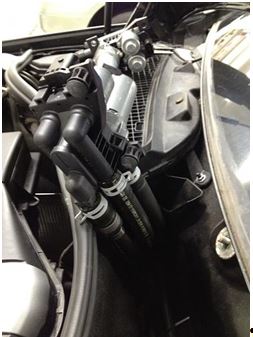Duo Valve: Difference between revisions
Ricebubbles (talk | contribs) (→Method 3 DIY Renew Brushes in Duovalve Circulation Pump: Added exact detail for brushes.) |
Ricebubbles (talk | contribs) (Moved Circulation Pump stuff to proper section.) |
||
| Line 18: | Line 18: | ||
===Issue 2 with Duovalve (NB LHD Vehicle)=== | ===Issue 2 with Duovalve (NB LHD Vehicle)=== | ||
I changed my duovalve a few days ago and learned some things while doing it. I had followed the original post which I found after cracking my windshield baffle that the pictures were specific to a W211, and not my W220. So I hope these pics and steps help some of you looking to do this repair. I can tell you that I have almost zero repair experience, as you can see from my rambling and poor pics and thought this repair was fairly easy if you take your time and follow the steps. The duovalve is located under the windshield wiper plate fairly close to where it is on the W211, so you can follow the first few steps of the W211 thread to get you started but here are the steps. | I changed my duovalve a few days ago and learned some things while doing it. I had followed the original post which I found after cracking my windshield baffle that the pictures were specific to a W211, and not my W220. So I hope these pics and steps help some of you looking to do this repair. I can tell you that I have almost zero repair experience, as you can see from my rambling and poor pics and thought this repair was fairly easy if you take your time and follow the steps. The duovalve is located under the windshield wiper plate fairly close to where it is on the W211, so you can follow the first few steps of the W211 thread to get you started but here are the steps. | ||
==DIY Procedures - Duo Valve== | ==DIY Procedures - Duo Valve== | ||
| Line 40: | Line 27: | ||
http://www.benzworld.org/forums/showthread.php?t=1271866http://www.benzworld.org/forums/w210-e-class/1570724-my-attempt-replacing-transmission-plug.html | http://www.benzworld.org/forums/showthread.php?t=1271866http://www.benzworld.org/forums/w210-e-class/1570724-my-attempt-replacing-transmission-plug.html | ||
Latest revision as of 12:10, 18 November 2016
Back to: WIS 83.40 Automatic Climate Control (ACC) or Heating Ventilation and Air Conditioning (HVAC)
Description - Duo Valve
In a LHD vehicle there is a duo valve in the Driver's (left) side rear engine compartment for the standard two zone ACC and, where fitted, a duo valve in the front right wheel well for the rear HVAC.
In a RHD vehicle there is a duo valve in the Driver's (right) side rear engine compartment for the standard two zone ACC and, where fitted, a duo valve in the front right wheel well (TO BE CONFIRMED) for the rear HVAC.
The next figure shows a Duo Valve partially removed from a LHD vehicle.

Issues - Duo Valve
Issue 1 with Duovalve (NB LHD Vehicle)
Acknowledgement of contributions by BenzWorld Members, finntexan and dcarveriii.
The duovalve in W220 is located in front of the firewall but behind the sound insulating wall. Four inches below the black plastic liner which is in front of the windshield. Just a little bit toward the driver's side from the car center line. You can barely see it under the hood when looking from the driver's side of the car.
Issue 2 with Duovalve (NB LHD Vehicle)
I changed my duovalve a few days ago and learned some things while doing it. I had followed the original post which I found after cracking my windshield baffle that the pictures were specific to a W211, and not my W220. So I hope these pics and steps help some of you looking to do this repair. I can tell you that I have almost zero repair experience, as you can see from my rambling and poor pics and thought this repair was fairly easy if you take your time and follow the steps. The duovalve is located under the windshield wiper plate fairly close to where it is on the W211, so you can follow the first few steps of the W211 thread to get you started but here are the steps.
DIY Procedures - Duo Valve
Method 1 for Duovalve (NB LHD Vehicle)
Refer to: http://www.benzworld.org/forums/w220-s-class/1271866-sorry-another-air-con-issue.html